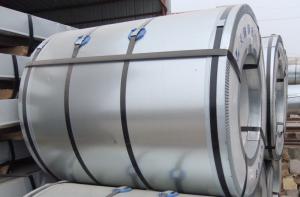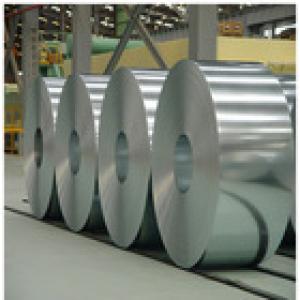Aluzinc Steel Coil-AFP
- Loading Port:
- China Main Port
- Payment Terms:
- T/T or L/C
- Min Order Qty:
- 25mt m.t.
- Supply Capability:
- 50000 Metric Tons per Month m.t./month
OKorder Service Pledge
OKorder Financial Service
You Might Also Like
General Information
|
Thickness: 0.25mm-4.0mm |
|
Width: 900mm-1250mm |
|
Alu-zinc Coating: 50-150g/m2 |
|
Internal Diameter: 508mm/610mm |
|
Coil Weight: 4-8MT |
|
Quality: commercial and structural quality |
|
Surface Treatment: oiled & dry, chromated, anti-finger, non-skin pass/ skin pass |
|
Standard: JIS G 3321, ASTM A792M, EN 10215 |
|
Steel Grade: SGCC, SGCD, CS,FS,SS,DX51D+Z DX52D+Z; S200GD, S220GD, S280GD, S350GD |
|
Package: full wrapped with anti-damped paper inside, iron sheet wrapped outside, and bundled by iron strips |
Technical Data
|
Chemical Composition |
C |
Si |
Mn |
P |
S |
|
0.04-0.06% |
0.01-0.03% |
0.18-0.22% |
0.014-0.016% |
0.006%-0.009% |
|
Technical Data | |
|
Yield Strength |
(Mpa) 280-320 |
|
Tensile Strength |
(Mpa) 340-390 |
|
Elongation |
20%-30% |
|
Out-of-square |
not exceed 1% Flatness |
|
Bow |
15mmmax |
|
Edge Wave |
9mmmax |
|
Centre Buckle |
8mmmax |
|
Bending At 180 Degree |
no crack, peeling and fraction |
Application
Aluzinc Steel can be widely used in transportation, light industry, civil usage and farming. It is also the perfect building material in construction for making roofing tile, steel profiles for wall partition, T-bar, studs, fireproof door, air conditioning duct and home appliance.
- Q:if steel is heated from room temperature (20c) to (500c) what would be the change in density?coefficient for linear expansion of steel 12x10^-6 k density of steel 7800 kg
- First you have to convert the coefficient of linear expansion to a coefficient of volumetric expansion. Multiply the coefficient of linear expansion by 3: Coefficient of expansion of steel,β:12E-6/°K x 3 = 36E-6/°K Difference in temperature: 480°K ΔV = VoβΔT ΔV = Vo x (0.000036) x 480 ΔV = 1m? x 0.017 ΔV = 0.017m? Originally, the steel was at 7800 kg/m? Now, the steel was at 7800 kg/ 1.017m?, or 7670 kg/m? Change in density = 7670 - 7800 = -130kg/m?
- Q:How are steel coils used in the production of signage?
- Steel coils are used in the production of signage as they provide a durable and versatile material for creating sturdy sign structures. The steel coils are typically cut into desired shapes and sizes, then bent, welded, or formed to create the framework of the signs. This allows for the creation of different types of signs, such as billboards, street signs, or large display signs. The steel coils' strength and resistance to weather make them ideal for outdoor signage that needs to withstand various environmental conditions.
- Q:What are the different types of surface defects in steel coils?
- Some of the different types of surface defects in steel coils include scratches, pits, rust, scale, stains, and indentations.
- Q:How do steel coils contribute to structural integrity in buildings?
- The role of steel coils in ensuring the structural integrity of buildings cannot be overstated. They play a vital role in multiple ways. To begin with, steel coils are extensively utilized in the construction industry to manufacture essential building components like beams, columns, and trusses. These components are responsible for providing support and stability to the overall structure. Due to their exceptional tensile strength and durability, steel coils guarantee that these components can withstand heavy loads and maintain their structural integrity over an extended period. This is particularly crucial in buildings with multiple floors or large open spaces, where the structural elements need to bear substantial weight without deforming or collapsing. Moreover, steel coils are also instrumental in reinforcing concrete structures. Reinforced concrete is a widely adopted construction technique, and steel coils, in the form of reinforcement bars or mesh, are embedded within the concrete to counteract tensile forces. While concrete excels at withstanding compressive forces, it is weak in tension. By incorporating steel coils, the composite material gains the ability to resist both compression and tension, thereby enhancing its structural integrity. This reinforcement technique is particularly vital in high-rise buildings or structures subject to seismic activity, where the risk of structural failure due to bending or cracking is heightened. Another significant contribution of steel coils to structural integrity lies in their corrosion resistance properties. Steel coils are often coated with protective layers, such as zinc through galvanization or paint, to prevent corrosion caused by moisture, chemicals, or environmental factors. Corrosion weakens the structural integrity of steel, leading to degradation and potential failure. By utilizing corrosion-resistant steel coils, the lifespan of the building is prolonged, and the risk of structural damage is significantly diminished. Furthermore, steel coils offer tremendous versatility in design and construction. Their flexibility and malleability allow for the creation of complex and intricate building structures, enabling architects and engineers to push the boundaries of design while maintaining structural integrity. Steel coils can be shaped, bent, and welded into various forms, making them an ideal material for constructing innovative and aesthetically pleasing buildings. In conclusion, steel coils are indispensable in ensuring the structural integrity of buildings. Their strength, stability, durability, corrosion resistance, and design versatility make them an essential material in modern construction, guaranteeing the safety and longevity of buildings for years to come.
- Q:Could someone please explain what happens when steel is heat treated and why these happenings cause the steel to become harder? Please dig down into the micro details of the crystallites but in somewhat laymen's terms. Also describe the processes which achieve these results; if you have the time. Thanks for your time and effort.
- If you are speaking of a micro mini skirt, then i would think that the answer would be 1000 Hostess HoHo's would equal a macro skirt.
- Q:Can cold rolled galvanized steel coils be acid washed after oxidation?
- If it has been galvanized, it can not be pickled, and if it is pickled, it may corrode the zinc layer
- Q:How are steel coils used in the manufacturing of railway bridges?
- Steel coils are used in the manufacturing of railway bridges as they are rolled and shaped into various structural components like beams, girders, and plates. These coils provide the necessary strength, durability, and flexibility required to support heavy loads and withstand the dynamic forces exerted on the bridge.
- Q:How are steel coils shipped internationally?
- Steel coils are typically shipped internationally using cargo ships or freight trains. The coils are securely loaded onto flatbed or container vessels, ensuring they are properly secured to prevent any damage during transportation. This method allows for efficient and cost-effective transportation of large quantities of steel coils across the globe.
- Q:Ok I know this sounds stupid but is there anyway to make stainless steel look older? It looks too new and I don't want it like that. Thanks.
- Its called stainless for a reason :) many grades are out there, 300 400 series. You could use acid to make it look older but you wouldnt want to cook with it after chemically converting it with acid.Personally i like cast iron. It will last a life time + and looks very cool. Sorry no safe way to do it and cook with it. B^
- Q:What are the dimensions of steel coils used in the packaging industry?
- The dimensions of steel coils used in the packaging industry can vary depending on the specific application and requirements. However, typical dimensions for steel coils used in packaging range from 0.15 mm to 3 mm in thickness and 600 mm to 2000 mm in width. The inner diameter of the coil, known as the core, is usually around 508 mm (20 inches), although other sizes such as 610 mm (24 inches) or 762 mm (30 inches) may also be used. The outer diameter of the coil can vary depending on the weight and size of the coil, but it is commonly around 1000 mm to 2000 mm. It is important to note that these dimensions can be customized based on the specific requirements and preferences of the packaging industry.
1. Manufacturer Overview |
|
|---|---|
| Location | Zhejiang, China |
| Year Established | 1999 |
| Annual Output Value | US$1 Million - US$2.5 Million |
| Main Markets | Europe; Africa; Mid East; Southeast Asia |
| Company Certifications | ISO9001;ISO14001 |
2. Manufacturer Certificates |
|
|---|---|
| a) Certification Name | |
| Range | |
| Reference | |
| Validity Period | |
3. Manufacturer Capability |
|
|---|---|
| a)Trade Capacity | |
| Nearest Port | Shanghai Port |
| Export Percentage | 41% - 50% |
| No.of Employees in Trade Department | 50-80 |
| Language Spoken: | Chinese, English |
| b)Factory Information | |
| Factory Size: | Above 100,000 square meters |
| No. of Production Lines | 5 |
| Contract Manufacturing | OEM Service Offered |
| Product Price Range | Average |
Send your message to us
Aluzinc Steel Coil-AFP
- Loading Port:
- China Main Port
- Payment Terms:
- T/T or L/C
- Min Order Qty:
- 25mt m.t.
- Supply Capability:
- 50000 Metric Tons per Month m.t./month
OKorder Service Pledge
OKorder Financial Service
Similar products
New products
Hot products
Related keywords




























